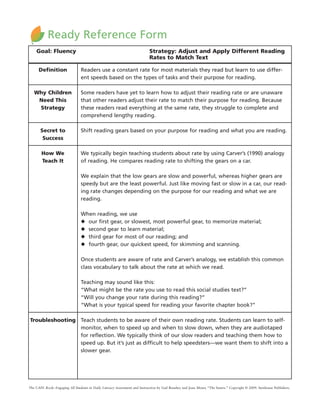
Reading Fluency
- 1. The CAFE Book: Engaging All Students in Daily Literacy Assessment and Instruction by Gail Boushey and Joan Moser, “The Sisters.” Copyright © 2009. Stenhouse Publishers. Ready Reference Form Goal: Fluency Strategy: Adjust and Apply Different Reading Rates to Match Text Definition Why Children Need This Strategy Secret to Success How We Teach It Troubleshooting Readers use a constant rate for most materials they read but learn to use differ- ent speeds based on the types of tasks and their purpose for reading. Some readers have yet to learn how to adjust their reading rate or are unaware that other readers adjust their rate to match their purpose for reading. Because these readers read everything at the same rate, they struggle to complete and comprehend lengthy reading. Shift reading gears based on your purpose for reading and what you are reading. We typically begin teaching students about rate by using Carver’s (1990) analogy of reading. He compares reading rate to shifting the gears on a car. We explain that the low gears are slow and powerful, whereas higher gears are speedy but are the least powerful. Just like moving fast or slow in a car, our read- ing rate changes depending on the purpose for our reading and what we are reading. When reading, we use ◆ our first gear, or slowest, most powerful gear, to memorize material; ◆ second gear to learn material; ◆ third gear for most of our reading; and ◆ fourth gear, our quickest speed, for skimming and scanning. Once students are aware of rate and Carver’s analogy, we establish this common class vocabulary to talk about the rate at which we read. Teaching may sound like this: “What might be the rate you use to read this social studies text?” “Will you change your rate during this reading?” “What is your typical speed for reading your favorite chapter book?” Teach students to be aware of their own reading rate. Students can learn to self- monitor, when to speed up and when to slow down, when they are audiotaped for reflection. We typically think of our slow readers and teaching them how to speed up. But it’s just as difficult to help speedsters—we want them to shift into a slower gear.